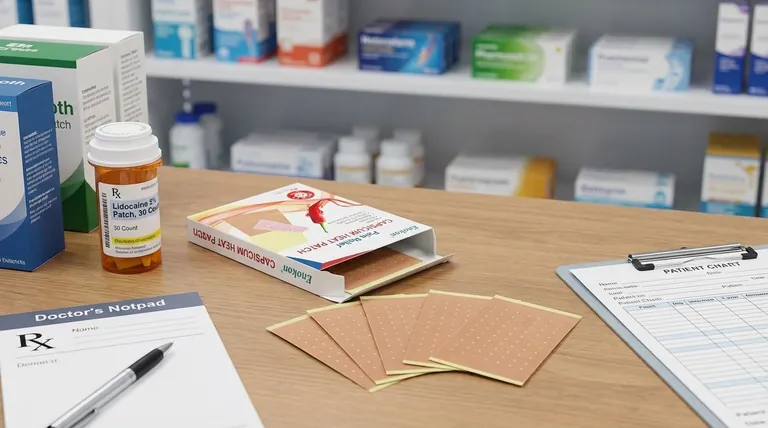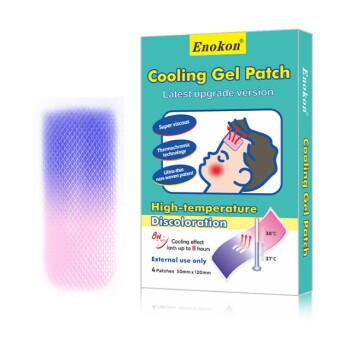Prescription anesthetic patches, such as medicated patches, are specialized transdermal treatments designed to deliver localized pain relief for specific conditions, particularly neuropathic pain. These patches contain active ingredients like lidocaine or capsaicin, which target nerve pain by blocking pain signals or desensitizing nerve fibers. They offer a non-invasive alternative to oral medications, minimizing systemic side effects while providing targeted relief. Common applications include postherpetic neuralgia (lingering pain after shingles) and diabetic neuropathy, where traditional painkillers may be less effective or carry higher risks.

Key Points Explained:
-
Mechanism of Action
- Lidocaine patches block sodium channels in peripheral nerve fibers (A-delta and C fibers), preventing pain signal transmission to the brain.
- Capsaicin patches work by depleting substance P, a neurotransmitter involved in pain perception, thereby desensitizing nerves over time.
- Both types provide localized relief without significant absorption into the bloodstream, reducing systemic side effects.
-
Primary Medical Uses
- Postherpetic neuralgia (PHN): Chronic burning or stabbing pain following shingles outbreaks.
- Diabetic neuropathy: Tingling, numbness, or pain due to nerve damage in diabetes patients.
- Sciatic nerve pain: Targeted relief for radiating pain along the sciatic nerve pathway.
-
Advantages Over Oral Medications
- Targeted delivery: Medication acts directly on the painful area, avoiding gastrointestinal absorption.
- Reduced side effects: Lower risk of liver/kidney strain or drug interactions compared to oral analgesics.
- Convenience: Long-lasting effects (e.g., 12-hour wear for lidocaine patches) with minimal dosing frequency.
-
Prescription Requirements
- Stronger formulations (e.g., high-dose lidocaine or capsaicin) require a prescription due to potency and potential skin reactions.
- Over-the-counter alternatives (e.g., counterirritant patches) are limited to mild musculoskeletal pain and lack anesthetic effects.
-
Patient Considerations
- Application: Patches must adhere to intact skin and avoid irritated or broken areas.
- Monitoring: Patients with sensitive skin may require testing for allergic reactions.
- Complementary therapies: Often used alongside oral medications or physical therapy for comprehensive pain management.
These patches exemplify how targeted drug delivery can address complex pain conditions while aligning with modern healthcare’s shift toward personalized, low-risk treatments. For chronic pain sufferers, they represent a discreet yet powerful tool to improve daily comfort and mobility.
Summary Table:
| Feature | Details |
|---|---|
| Mechanism | Blocks sodium channels (lidocaine) or depletes substance P (capsaicin). |
| Primary Uses | Postherpetic neuralgia, diabetic neuropathy, sciatic nerve pain. |
| Advantages | Targeted delivery, reduced systemic side effects, long-lasting relief. |
| Prescription Needed? | Yes, for high-dose formulations; OTC options lack anesthetic potency. |
| Patient Tips | Apply to intact skin, monitor for allergies, combine with other therapies. |
Need reliable prescription-grade anesthetic patches for your patients? Partner with Enokon, a trusted bulk manufacturer of transdermal pain relief solutions. We specialize in high-quality medicated patches tailored for healthcare distributors and brands. Benefit from our expertise in custom R&D to develop formulations that meet specific clinical needs. Contact us today to discuss your requirements and elevate your pain management offerings!
Visual Guide

Related Products
- Capsaicin Chili Medicated Pain Relief Patches
- Mugwort Wormwood Pain Relief Patch for Neck Pain
- Menthol Gel Pain Relief Patch
- Icy Hot Menthol Medicine Pain Relief Patch
- Heating Pain Relief Patches for Menstrual Cramps
People Also Ask
- Can children use the pain relief patch? A Critical Safety Guide for Parents
- Are natural and herbal pain relief patches effective and safe? Discover the Benefits of Targeted Relief
- How do you apply the Signal Relief patch to find the proper placement? A Step-by-Step Guide to Maximum Relief
- What is the purpose of capsaicin patches? A Guide to Temporary Pain Relief
- Are pain relief patches safe for sensitive skin? Your Guide to Safe Use & Skin Testing

















